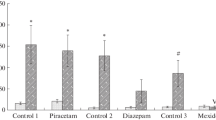Abstract
F344 male rats were trained in shuttle-box avoidance to a criterion of over 90% avoidance, and independent groups of subjects (Ss) were then given 13 daily injections of 5, 10, or 20 mg/kg of morphine or saline (s.c.) 30 min prior to testing. In Experiment 1, Ss were injected and tested on each of the 13 days while in Experiment II, Ss were injected daily but tested only on Day 13. Five mg/kg of morphine did not decrease avoidance responding. While 10 mg/kg initially caused a decrease in avoidance responses, responding rapidly returned to the pre-injection level. For the groups receiving either 5 or 10 mg/kg there was an increase in locomotor activity and a decrease in response latencies when compared to saline controls on Day 13. The 20 mg/kg dose initially disrupted avoidance, but not escape, responses but after 13 daily injections avoidance responses were near pre-injection levels even though locomotor activity remained above baseline. Results of the two experiments were identical for drug Day 13 suggesting that Ss injected and run daily had not merely learned to respond under the influence of the drug but had developed tolerance to the drug.
Similar content being viewed by others
References
Adams, W. J., Yeh, S. Y., Woods, L. A., Mitchell, C. L.: Drug-test interaction as a factor in the development of tolerance to the analgesic effect of morphine. J. Pharmacol. exp. Ther. 168, 251–257 (1969).
Akera, T., Brody, T. M.: The addiction cycle to narcotics in the rat and its relation to catecholamines. Biochem. Pharmacol. 17, 675–688 (1968).
Barrett, R. J., Ray, O. S.: Behavior in the open field, Lashley III maze, shuttle-box, and Sidman avoidance as a function of strain, sex, and age. Develop. Psychol. 3, 73–77 (1970).
Chittal, S. M., Sheth, U. K.: Effect of drugs on conditioned avoidance response in rats. Arch. int. Pharmacodyn. 144, 471–480 (1963).
Cochin, J., Kornetsky, C.: Development and loss of tolerance to morphine in the rat after single and multiple injections. J. Pharmacol. exp. Ther. 145, 1–10 (1964).
Cook, L., Weidley, E.: Behavioral effects of some psychopharmacological agents. Ann. N. Y. Acad. Sci. 66, 740–752 (1957).
Dallemagne, G.: Traitement prolonge a la morphine chez le rat: interaction drogue/compartement dans des conditionnements sous controle aversif. Psychopharmacologia (Berl.) 20, 77–84 (1971).
Djahanguiri, B., Richelle, M., Fontaine, O.: Behavioral effects of a prolonged treatment with small doses of morphine in cats. Psychopharmacologia (Berl.) 9, 363–272 (1966).
Ferguson, R. K., Adams, W. J., Mitchell, C. L.: Studies of tolerance development to morphine analgesia in rats tested on the hot plate. Europ. J. Pharmacol. 8, 83–92 (1969).
Heifetz, S. A., McMillan, D. E.: Development of behavioral tolerance to morphine and methadone using the schedule-controlled behavior of the pigeon. Psychopharmacologia (Berl.) 19, 40–52 (1971).
Herz, A.: Drugs and the conditioned avoidance response. Int. Rev. Neurobiol. 2, 229–277 (1960).
Kayan, S., Woods, L. A., Mitchell, C. L.: Experience as a factor in the development of tolerance to the analgesic effect of morphine. Europ. J. Pharmacol. 6, 333–339 (1969).
Khazan, N., Weeks, J. R., Schroeder, L. A.: Electroencephalographic, electromyographic and behavioral correlates during a cycle of self-maintained morphine addiction in the rat. J. Pharmacol. exp. Ther. 155, 521–531 (1967).
Kornetsky, C., Bain, G.: Morphine: single-dose tolerance. Science 162, 1011–1012 (1968).
Maynert, E. W.: Some aspects of the comparative pharmacology of morphine. Fed. Proc. 26, 1111–1114 (1967).
Morpurgo, C.: Drug-induced modification of discriminated avoidance behavior in rats. Psychopharmacologia (Berl.) 8, 91–99 (1965).
Seevers, M. H., Deneau, G. A.: A critique of the “Dual Action” hypothesis of morphine physical dependence. Arch. int. Pharmacodyn. 140, 514–520 (1962).
Sloan, J. W., Brooks, J. W., Eisenman, A. J., Martin, W. R.: Comparison of the effects of single doses of morphine and thebaine on body temperature, activity, and brain and heart levels of catecholamines and seratonin. Psychopharmacologia (Berl.) 3, 291–301 (1962).
Tamayo, L., Conteras, E.: Effect of training on the analgesic action of morphine. Europ. J. Pharmacol. 11, 96–100 (1970).
Verhave, T., Owen, J., Robbins, E. B.: The effect of morphine sulfate on avoidance and escape behavior. J. Pharmacol. exp. Ther. 125, 248–251 (1959).
Winer, B. J.: Statistical principles in experimental design. New York: McGraw Hill 1962.
Author information
Authors and Affiliations
Rights and permissions
About this article
Cite this article
Herman, S.J., Freeman, B.J. & Ray, O.S. The effects of multiple injections of morphine sulfate on shuttle-box behavior in the rat. Psychopharmacologia 26, 146–154 (1972). https://doi.org/10.1007/BF00422101
Received:
Revised:
Issue Date:
DOI: https://doi.org/10.1007/BF00422101




